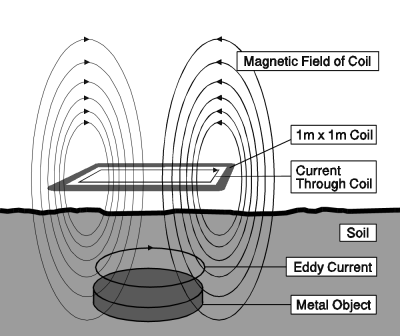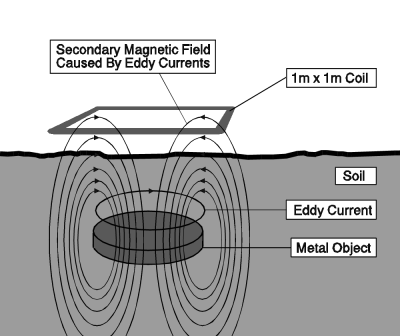

| 1 Function |
|
|
The PULSE STAR II is a PULSE-INDUCTION (PI) system which incorporates a large search coil (one meter by one meter as standard equipment) for the main purpose of finding large objects at great depths. These detection depths can almost be compared with those of magnetometers, which can detect nothing but ferromagnetic objects. Another great advantage of using the PULSE STAR II together with the large search coil is being able to cover a large area in a short period of time. The actual search coil is encased in a square plastic frame (PVC tubing) and can be carried by one or two persons.
Using the PI-principle offers some decisive advantages. First, the search coil is not part of a resonant circuit as it is the case with VLF detectors and can, therefore, be of almost any size and shape. This is absolutely necessary in order to increase the location depth considerably. In the second place there is a timely discoupling between the transmitting and the receiving phase which makes it possible to work with far greater transmission power.
A further advantage is that small objects like bottle caps, pull tabs, pieces of aluminium foil, but also single coins are naturally rejected while using the large search coils.
But still the PULSE STAR II is an easy-to-operate metal detector: you only have to deal with four simple controls, of which you need just one while normal operation.
Objects are simultaneously indicated by a meter and by an audio signal which increases in frequency while approaching the object. The audio response has a very wide frequency range in order to avoid signal saturation when the search coil approaches a very close object. This makes it easy to pinpoint the exact location.
The function of the PULSE STAR II is divided into two time intervals:
| Transmission Phase | |
| A strong duty current is flowing through the search coil about 600 times per second. The linearly increasing current builds up a primary magnetic field which radiates as shown in Fig. 2. The current is abruptly cut off after a certain time, so that the primary magnetic field collapses quickly causing so-called eddy currents in the metal object. Strength and duration of these eddy currents depend on the electrical conductivity, size and shape of the object. After a short time delay the search coil is connected to the receiver input. |  |
| Fig. 2: Transmitting Phase | |
| Receiving phase | |
| The decay of the eddy currents in the object produces a secondary magnetic field, which is radiated by the object (Fig. 3). This secondary magnetic field has its effect also on the coil and here induces very low voltages, which are amplified and displayed by a meter and an audio signal. Obviously the detection range has physical limits, because these voltages are extremely weak and can be obscured by external magnetic fields. |  |
| Fig. 3: Receiving phase |
In general, the possible detection range will increase quickly with increasing target size. This is especially true for the PI-principle. But the electrical conductivity and the shape of the object are also important factors.
Related to this, ferromagnetic metals take a special position. If these metals are exposed to the magnetic fields of a PI-detector, they will be momentarily magnetized. Although the electrical conductivity of these metals is poor and, therefore, the decay of the eddy currents is very short, the strength and the slow decay of the magnetization causes a strong signal. This is why PI-detectors are very sensitive to even small ferrous objects. The PULSE STAR II offers you the possibility of reducing the sensitivity to these objects (some smaller ferrous objects can even be completely rejected), while still being sensitive to most non-ferrous metals.
With a rather complicated electronic analysis of the decay of the objects magnetic fields we were able to provide the PULSE STAR II with a metal discrimination. Since the signals that have to be analyzed are even smaller than the normal detection signals, the discrimination range is limited to about 60 to 80 % of the normal detection range. Additionally, motion of the search coil is required in order to receive a ferrous or non-ferrous indication.
Also, the discrimination can only function with objects of a minimum size of about 10cm (4 inches) in diameter. The influence of shape and position is too large when detecting small objects. The PULSE STAR II measures the electrical conductivity of the metal object. As ferrous metals have, compared to most non-ferrous metals, a poor conductivity it is possible to differentiate. However, you have to pay attention to the following: almost all objects smaller than previously mentioned will cause a ferrous reading. The same applies to thin foils (e.g. large aluminium foils). An accumulation of several smaller non-ferrous objects (for example some silver coins) have not the same characteristics as one bigger single piece, so that again a ferrous metal may be indicated. Additionally, the conductivity of some non-ferrous metals, like lead or tin, as well as of some alloys is even lower than that of iron, so that they may be classified as ferrous objects. However, for large objects there will rarely be an anomaly effect (a non-ferrous indication although it is a ferrous metal) which plagues most VLF/TR detectors.
If there are both ferrous and non-ferrous metals in the detection range (e.g. non-ferrous metals in an iron box), usually the larger one of these objects will be indicated.
VLF/TR detectors do offer excellent discrimination features for small objects. The PULSE STAR II has the greatest advantage of detecting and discriminating medium and large size objects.
Brief summary of the advantages and capabilities of the PULSE STAR II metal detector:
| Introduction | Chapter 2 |